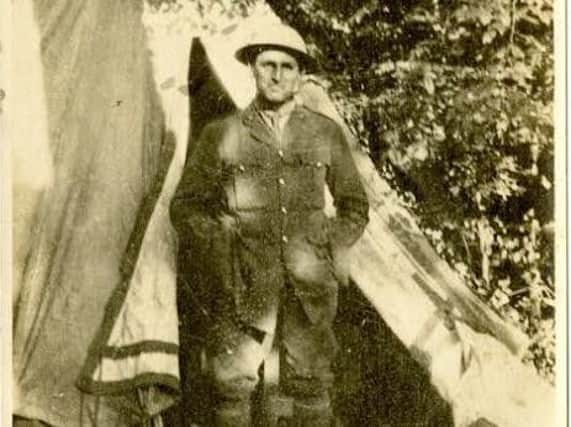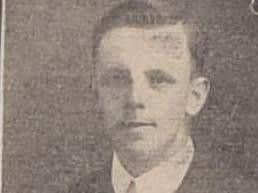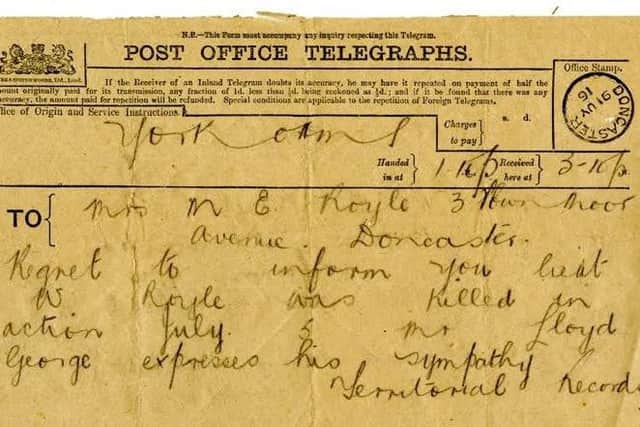SOMME ANNIVERSARY: Two Doncaster heroes who died in first days of WW1's bloodiest battle


WILLIAM ROYLEWilliam died during the first week of the Somme - and a series of letters and photographs received after his death helped his family piece together his last days.
William ‘Billie’ Royle was born in 1891 in Doncaster, the son of Thomas Clifford Royle, the local registrar of births of deaths.


Advertisement
Hide AdAdvertisement
Hide AdHe lived at 67 Nether Hall Road with his parents and three brothers, Francis, Reginald and Frederick and was educated at Beechfield Junior Boys School and later Doncaster Grammar School.
A well-known member of the community, performing in the Parish Church choir and part of the Doncaster Operatic Society, yhe family later moved to 3 Town Moor Avenue and a younger brother, Harold, was born.
William worked for the Joint Stock Bank at Doncaster, later moving to their Mexborough branch but signed up to serve with the Sheffield Pals Battalion of the York and Lancaster Regiment soon after the outbreak of war, later obtaining a commission in the 3/5 battalion King’s Own Yorkshire Light Infantry as a Second Lieutenant.


William was killed in action on the July 5 1916 and a telegram was sent to his parents on Town Moor Avenue to notify them.
Advertisement
Hide AdAdvertisement
Hide AdIn October 1916, Mrs Royle received a letter from Lillie Stones at 35 Casualty Clearing Station in France.
Lillie described how sad she was to hear of Billie’s death, writing that she had tea with him in Rouen when he was on his way up the lines.
She went on to write that she had just had a patient in her ward named Private Addy who was with William when he was killed.


Private Addy told Lillie that William never spoke after he was wounded and died immediately. Private Addy was close to Billie, having been recommended for the Military Medal by Billie and another comrade named Smith.
Advertisement
Hide AdAdvertisement
Hide AdShe went on to write: ”Billie was killed at Thiepval and I wrote to tell you this in case you have not been able to get any particulars, as I hear that there were only about 10 men returned out of the Company.”
In February 1917, William’s mother Mary received another surprise letter from one W. L. Lister.
A comrade of William’s, W. L. Lister was forwarding some photographs of William taken by Second Lieutenant G N Smith a few days before the beginning of action at the Battle of the Somme.


Lieutenant Smith had copies made for Billie’s mother and had just gone back to France, requesting they be forwarded to her. W. L. Lister also wrote that photography was not allowed and that’s why it had taken so long for the photographs to come to light.
Advertisement
Hide AdAdvertisement
Hide AdBillie’s brothers Reginald (Rex), Francis and Frederick all served during the First World War, while their youngest brother Harold was too young to serve, but received regular letters from his older brothers abroad.
Billie is remembered on the Thiepval Memorial, France, the memorial which remembered the missing of the Somme with no known grave.
LANCE CORPOPRAL CHARLES HARSLEY
Lance Corporal Charles Harsley died on the very first day of the battle - and tragically, never saw his newborn daughter.
Charles was born in Hull in 1890, the son of Harry, a joiner, and his wife Martha.
Advertisement
Hide AdAdvertisement
Hide AdHe had four younger sisters, the oldest Ethel, like Charles, born when the family lived in Hull.
They moved to Doncaster when Charles was little and where his other three sisters were born.
The family lived at 22 Apley Road but later moved to 61 Abbott Street - both in the Hyde Park area.
After leaving school, Charles worked as a gas fitter for Doncaster Corporation and continued living with the family who in time moved to Lowther Road in Wheatley where he was a member of the Wheatley Club.
Advertisement
Hide AdAdvertisement
Hide AdWhen war broke out, Charles was keen to enlist and volunteered in September 1914.
A few days later, he married his fiancée, Helen McKone and the pair set up home at 68 Beckett Road before Charles went off to fight in France.
Tragically he was killed in action on July 1, 1916 - the very first day of the Battle of the Somme.
Helen subsequently received what must have been a very poignant letter from a soldier in the Irish Guards.
Advertisement
Hide AdAdvertisement
Hide AdHe had enclosed Charles’ pay book and postcard photos of herself and their daughter, which had been found on the battle field.
Their little girl was only seven months old when Charles died -and he had never seen her in the flesh, only in those photos.
He is commemorated on the Thiepval Memorial, the memorial to the missing of the Somme.
Helen died in 1980 in Wandsworth.
